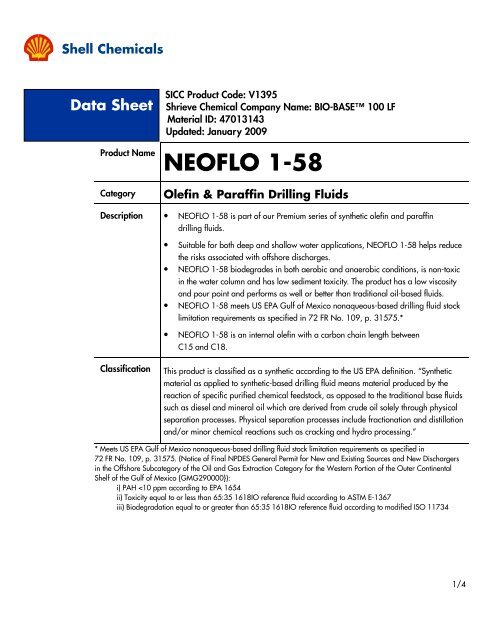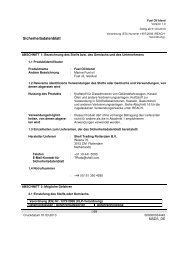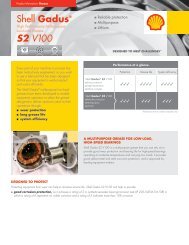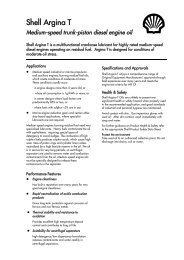NEOFLO 1-58
NEOFLO 1-58
NEOFLO 1-58
Create successful ePaper yourself
Turn your PDF publications into a flip-book with our unique Google optimized e-Paper software.
Data Sheet<br />
Product Name<br />
SICC Product Code: V1395<br />
Shrieve Chemical Company Name: BIO-BASE 100 LF<br />
Material ID: 47013143<br />
Updated: January 2009<br />
<strong>NEOFLO</strong> 1-<strong>58</strong><br />
Category Olefin & Paraffin Drilling Fluids<br />
Description • <strong>NEOFLO</strong> 1-<strong>58</strong> is part of our Premium series of synthetic olefin and paraffin<br />
drilling fluids.<br />
• Suitable for both deep and shallow water applications, <strong>NEOFLO</strong> 1-<strong>58</strong> helps reduce<br />
the risks associated with offshore discharges.<br />
• <strong>NEOFLO</strong> 1-<strong>58</strong> biodegrades in both aerobic and anaerobic conditions, is non-toxic<br />
in the water column and has low sediment toxicity. The product has a low viscosity<br />
and pour point and performs as well or better than traditional oil-based fluids.<br />
• <strong>NEOFLO</strong> 1-<strong>58</strong> meets US EPA Gulf of Mexico nonaqueous-based drilling fluid stock<br />
limitation requirements as specified in 72 FR No. 109, p. 31575.*<br />
• <strong>NEOFLO</strong> 1-<strong>58</strong> is an internal olefin with a carbon chain length between<br />
C15 and C18.<br />
Classification This product is classified as a synthetic according to the US EPA definition. “Synthetic<br />
material as applied to synthetic-based drilling fluid means material produced by the<br />
reaction of specific purified chemical feedstock, as opposed to the traditional base fluids<br />
such as diesel and mineral oil which are derived from crude oil solely through physical<br />
separation processes. Physical separation processes include fractionation and distillation<br />
and/or minor chemical reactions such as cracking and hydro processing.”<br />
* Meets US EPA Gulf of Mexico nonaqueous-based drilling fluid stock limitation requirements as specified in<br />
72 FR No. 109, p. 31575. (Notice of Final NPDES General Permit for New and Existing Sources and New Dischargers<br />
in the Offshore Subcategory of the Oil and Gas Extraction Category for the Western Portion of the Outer Continental<br />
Shelf of the Gulf of Mexico {GMG290000}):<br />
i) PAH
Typical<br />
Chemical<br />
Properties<br />
Typical<br />
Physical<br />
Properties<br />
Property Unit Value Method<br />
C14 & Lower %m/m 0.4 SCG 1086<br />
C15 %m/m 20.2 SCG 1086<br />
C16 %m/m 28.6 SCG 1086<br />
C17 %m/m 29.4 SCG 1086<br />
C18 %m/m 17.4 SCG 1086<br />
C19 & Higher %m/m 4.0 SCG 1086<br />
n-internal Olefins %m/m 91.0 Typical<br />
Branched Olefins %m/m 6.1 SCG 1086<br />
n-alpha Olefins %m/m 2.8 Typical<br />
Total Paraffins %m/m 0.1 SRC 00251<br />
Appearance Clear & substantially free of visible impurities<br />
Color, Pt-Co < 5 ASTM D 1209<br />
Water PPM 20 ASTM D 4672<br />
Property Unit Value Method<br />
Density @ 20°C kg/m 3 787 ASTM D 4052<br />
Flashpoint °C 135 ASTM D 3278<br />
Fire Point °C 146 ASTM D 92<br />
Pour Point °C -12 ASTM D 97<br />
Aniline Point °C 78 ASTM D 611<br />
Kinematic viscosity ASTM D 445<br />
@ 0°C cSt 7.8<br />
@ 40°C cSt 2.9<br />
@ 100°C cSt 1.3<br />
Boiling Range ASTM D 2887<br />
5% °C 268<br />
95% °C 367<br />
Vapor Pressure @ 40°C mmHg < 0.05 Calculated 1<br />
1 Calculated from data on single carbon number olefins.<br />
<strong>NEOFLO</strong> 1-<strong>58</strong> 2/4
Typical<br />
Environmental<br />
Properties<br />
Storage and<br />
Handling<br />
Hazard<br />
Identification<br />
Property Method/Endpoint Value Notes<br />
Biodegradation<br />
Anaerobic Modified ISO 11734 275-d 70 % BRR 1 = 0.6<br />
Aerobic OECD 301 D 28-d <strong>58</strong> %<br />
Aerobic ISO CO2 Headspace 28-d 73 %<br />
Aerobic OECD 306 28-d 76 %<br />
Water Column Toxicity<br />
Acartia tonsa 48-h EC50 > 1000 mg/L<br />
Skeletonema costatum 72-h EC50 > 1000 mg/L<br />
Cyprinodon variegatus OECD 203 96-h LC50 > 1000 mg/L<br />
Mysidopsis bahia 96-h LC50 > 1000 mg/L<br />
Mysidopsis bahia 96-h LC50 SPP 2 > 10 6 mg/L<br />
Scophthalmus maximus OECD 203 96-h LC50 > 1500 mg/L<br />
Sediment Toxicity<br />
Leptocheirus plumulosus Natural sediment 10-d LC50 8100 mg/kg STR 3 = 0.8<br />
Leptocheirus plumulosus Formulated sediment 10-d LC50 2700 mg/kg STR 3 = 0.8<br />
PAH EPA 1654A < 5 mg/kg<br />
1<br />
BRR = biodegradation rate ratio (% biodegradation of C1618 internal olefin reference/% biodegradation of test material)<br />
2<br />
SPP = suspended particulate phase<br />
3<br />
STR = sediment toxicity ratio (C1618 internal olefin reference LC50/test material LC50)<br />
<strong>NEOFLO</strong> products may be stored in carbon steel tanks. Hoses manufactured from<br />
polyethylene, butyl rubber, or neoprene liners are suitable for discharging. A nitrogen<br />
blanket is recommended to reduce potential for product degradation. Antioxidants can<br />
be added, upon request, to enhance the long-term stability. The recommended storage<br />
temperature is 20°C, the recommended maximum is 65°C and the recommended<br />
minimum is -5°C to prevent freezing. <strong>NEOFLO</strong> 1-<strong>58</strong> is classified as “non-regulated” by<br />
the United States Department of Transportation (US DOT). Additional advice on the<br />
storage and handling of <strong>NEOFLO</strong> products can be found at www.shell.com/chemicals,<br />
or by contacting your local Shell chemicals companies representative.<br />
<strong>NEOFLO</strong> products have been demonstrated to have a relatively low order of toxicity by<br />
the routes of exposure (oral, dermal, inhalation) encountered in normal handling. Like<br />
many hydrocarbon liquids, olefins will dry and de-fat the skin on prolonged contact and<br />
will result in skin irritation and dermatitis. Also, like other hydrocarbons, this product can<br />
be dangerous when aspirated or ingested. Before handling the product, refer to the<br />
Material Safety Data Sheet that is available from your local Shell chemicals companies<br />
representative. Additional information can be found at www.shell.com/chemicals in the<br />
Material Safety Data Sheet section.<br />
<strong>NEOFLO</strong> 1-<strong>58</strong> 3/4
Emergency<br />
Helpline<br />
Shell<br />
Warranties<br />
Europe (Rotterdam) + 31 (0) 10 431 3233<br />
Americas (United States) + 1 800 424 9300<br />
Asia (Singapore) +65 6263 2974<br />
Or call the emergency telephone number mentioned in the Safety Data Sheet<br />
relevant for your company’s country and language.<br />
The information contained in this publication is to the best of our knowledge, true and<br />
accurate, but any recommendations or suggestions that may be made are without<br />
guarantee, since the conditions of use are beyond our control. Furthermore, nothing<br />
contained herein shall be construed as a recommendation to use any product in conflict<br />
with existing patents covering any material or its use.<br />
The expression ‘Shell Chemicals’ refers to the companies of the Shell Group engaged in<br />
chemical businesses. Each of the companies which make up the Shell Group of<br />
companies is an independent entity. The “Shell Group” refers to the companies in which<br />
Royal Dutch Shell plc directly and indirectly owns investments.<br />
<strong>NEOFLO</strong> is a trademark owned and used by companies of the Shell Group.<br />
Shrieve Chemical Products, Inc., located in The Woodlands, Texas, is a privately owned,<br />
independent supplier of performance fluids and specialty chemicals including drilling<br />
fluids, additives ad production chemicals.<br />
BIO-BASE is a trademark of Shrieve Chemical Products Company.<br />
<strong>NEOFLO</strong> 1-<strong>58</strong> 4/4









